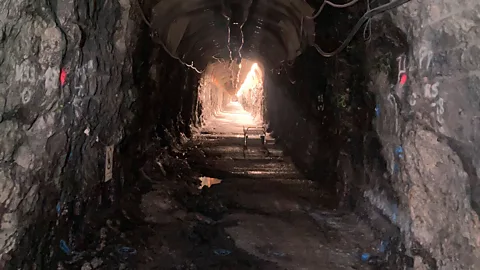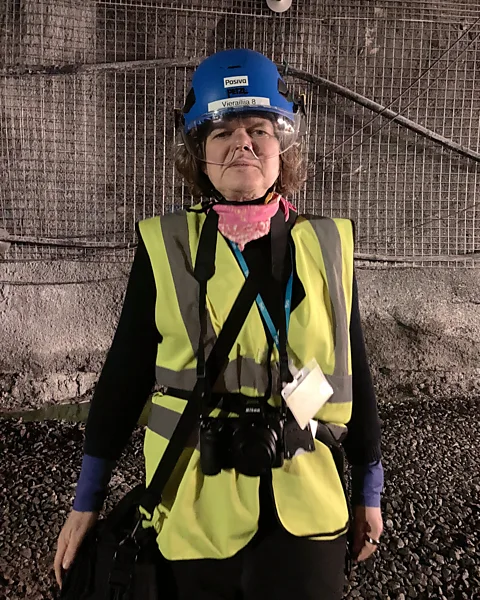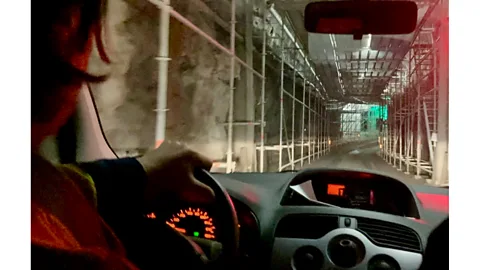The place where no humans will tread for 100,000 years
 Erika Benke
Erika BenkeIn a few years, Finland will begin depositing spent nuclear fuel underground in Onkalo, where it will remain for millennia. Erika Benke describes her experience of visiting the site.
I'm always upbeat on the way to interviews. To me they're the most enjoyable part of the storytelling process.
But this time I feel different. A tour at Onkalo, which lies 450m (1,480ft) below the ground, to see tunnels hewn in the living rock to store highly radioactive waste for 100,000 years, suddenly makes me nervous.
Finland's plan to bury spent nuclear fuel for millennia
Finland is on the verge of becoming the first nation to bury spent nuclear fuel rods deep underground for the long term.
Read about the science – and the controversies – behind the scheme in Erika Benke's accompanying in-depth article for BBC Future Planet.
I'm about to visit the world's first permanent storage site for spent nuclear fuel.
As I drive on a near-empty road in southwest Finland, I slow down trying to imagine what this picture-postcard Nordic countryside with huge pine trees would look like in 1,000 years. Or 10,000.
Will there be any people in the pretty houses dotted around Olkiluoto island? If so, will they speak Finnish? Will they use a language at all? And, most crucially, will they know about the potential danger lurking in the ground under their feet at Onkalo? (Read more about how to communicate a nuclear warning 10,000 years into the future.)
Spent fuel rods from nuclear power stations are currently kept in temporary storage facilities around the world.
Finland is the first country implementing what it hopes is a permanent solution. Starting in two or three years, highly radioactive waste will be buried deep in the bedrock at Onkalo, after being encased in cast-iron and copper cylinders and wrapped in bentonite clay.
I didn't feel remotely anxious when I spoke to people at Onkalo on the phone. But I feel apprehensive now. It helps that our hosts from Posiva, the company running the site, show us a safety video first. I watch it with fellow visitors, two German TV crews.
The video hits a tone of sensible down-to-earth pragmatism. Don't get separated from the group. In an emergency, follow your guide's instructions. It's an active construction site so watch out for vehicles and machines. If there's a fire, follow your guide to the nearest shelter. The video shows a group of people calmly walking into a fire-proof pod with its own oxygen supply. Once inside, their guide hands everybody a bottle of water. It all looks very organised.
"Have you ever been in an emergency down there?”, I ask one of our guides, Johanna Hansen, research and development coordinator at Posiva.
"Only one, but it was a false alarm," she replies with a smile.
Next we're asked to don our safety gear: a bright yellow high-visibility jacket, waterproof boots, a helmet with a visor and a belt with a torch. We're each handed a small pack containing an escape hood that will protect us from fire-related gases for 15 minutes. I'm relieved to hear that the helmets have a tracking device so people in the control room above the ground will always know where I am in the tunnels.
With that reassuring thought I walk through the turnstile at a security gate under the blazing midday sun and get into a car. Our guide drives into the service tunnel without hesitation. In a moment, everything turns very dark.
It takes 15 minutes to drive down to Onkalo's service station which lies 437m (1,430ft) below the ground. As the 4.5km-long (2.8 mile) tunnel begins to snake down, we see a standard traffic sign for a 20km/h (12mph) speed limit. There are also green signs on the tunnel wall at regular intervals indicating how far we are from the surface.
 Erika Benke
Erika BenkeIt's a lot less scary than I thought it would be. I think what makes me relax is to see that we're not alone. The tunnel is narrow – it's for one vehicle – but when we pass a bay, we catch glimpses of trucks and cars. It's like driving in a busy construction site, just set in a cave.
We arrive at the service station surprisingly quickly: a spacious, well-lit chamber with crushed stone underfoot. There's a lot of heavy machinery and a row of large containers filled with construction materials. Two men standing on a cherry picker attached to harnesses are working on ventilation shafts in the ceiling. Two other workers are in conversation over containers surrounded by massive cables.
It feels oddly normal: people are going about their jobs as if they were in a factory above the ground. It's a pleasant 14C (57F) and the air is clean: a ventilation system has been installed and there's no smell of dust or moisture.
You might also like:
Our guides explain how nuclear waste canisters will arrive at the service area in a lift running straight down from the encapsulation plant on the surface. We can't see the lift shaft – its construction is still underway. For now, it's covered by a large door marked with two large red Xs.
When the spent fuel starts being stored here, canisters will be lowered from this lift landing area further down to a deposition tunnel where they'll be picked up by robotic vehicles to take them to vertical deposition holes – their final resting places.
 Erika Benke
Erika BenkeWe're shown a demonstration deposition tunnel. Its entrance is a lot darker than the service area and the floor is uneven and wet, muddy in places. The walls are bare bedrock that glints in the torchlight.
Carbon Count
The emissions from travel it took to report this story and the accompanying in-depth article about Onkalo published by BBC Future Planet were 80kg CO2. The digital emissions from this story are an estimated 1.2g to 3.6g CO2 per page view. Find out more about how we calculated this figure here.
I realise that I've lost a small pink cable that connects my camera to the radio mic and I go back to find it. This is when I feel a moment of dread.
I'm alone in a dark tunnel where spent nuclear fuel will decay for millennia. I'm standing at a spot where, starting from 2025, no human should set foot for 100,000 years.
It brings home so clearly how brief our lives are. I fleetingly contemplate how minuscule a part of 100,000 years my own life is.
I find myself having a flashback from 30 years ago, skiing in the Alps, surrounded by fog so heavy that I didn't know which way was up or down.
That was my first powerful glimpse of how fragile we are when facing the power of Earth. Onkalo's bedrock has given me the second.
--
